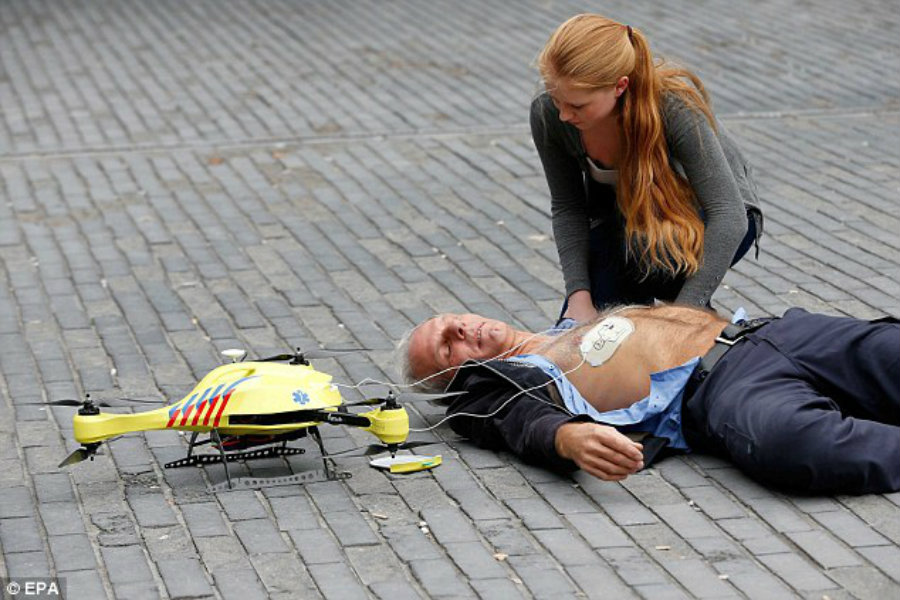A new study suggests that defibrillator-carrying drones could help save lives. The simulated study found that drones carrying a defibrillator –which may be used by a member of the public- arrived 16 minutes faster than emergency ambulances, saving much needed time.
Drones are already being used for anything from military to recreational use. Drones delivered thousands of condoms on villages in rural Africa, islands have quickly received medical supplies, and scientists have been able to send biological specimens to distant pathology labs.

Now, the researchers from Sweden are claiming that drones could be used to save lives too, delivering defibrillators that are most needed when a person suffers from cardiac arrest. The study was published Tuesday in the journal JAMA.
Defibrillator-carrying drones were sent to areas where someone had a cardiac arrest
Jacob Hollenberg, the director of the center for resuscitation science at the Karolinska Institute in Stockholm, who led the new study, told The Guardian that cardiac arrest is one of the major killers in the western world and that every minute –and every second- is crucial.
“Every minute that passes from collapse to [cardiopulmonary resuscitation] or defibrillation, the chances of survival goes down by 10 percent,” said Hollenberg, according to The Guardian. “That’s why survival after 10 to 12 minutes is basically zero. There’s a huge difference in using the defibrillator within the first few minutes. Even if you improve the timing of the ambulances in these type of situations, it’s too late – only one in 10 victims survive.”
For the study, they used a drone that weighed 5.7 kg, which was developed by the Swedish Transportation Agency to carry a 763g automated external defibrillator (AED). The eight-rotor unmanned aerial drone has a maximum cruising speed of 75 km/h (47 mph), and it was housed at a fire station located in the north of Stockholm.
Over a 72-hour period in October of last year, the emergency response drone was dispatched 18 times by two licensed pilots using GPS coordinates to out-of-sight locations where cardiac arrests within a 10 km radius from the fire station had been reported between 2006 and 2014.
The researchers also found that the median time from call dispatch of the emergency services was 3 minutes and 0 seconds on average, compared with 3 seconds for the drone. The median time from dispatch to the arrival of the drone stood at 5 minutes and 21 seconds, while the median time from the emergency services was 22 minutes and 0 seconds.
Study found that drones arrived more quickly by over 16 minutes
The emergency response drone arrived faster than the emergency services in every case they staged, with a median reduction in response time of 16 minutes and 39 seconds over an average flight distance of about two miles.
“If we can decrease the time in cardiac arrest from collapse to defibrillation by a few minutes, hundreds of lives would be saved each year,” said Hollenberg, according to New Scientist.
There were some limitations in the study, including the small number of flights over short distances in good weather, as well as the possibility of changes in traffic patterns from the period between 2006 and 2014 to this year.

Furthermore, the outcomes between those who receive resuscitation from an emergency service and a bystander using an AED were not compared in the new study, although Hollenberg believes that defibrillators are easier to use than a fire extinguisher.
Hollenberg expects that defibrillator-carrying drones could begin operating in Sweden in one or two years, although he noted there is work to be done before then. A larger scale trial must be conducted before to assess if results are the same, and agreements need to be reached with the aviation authorities. Currently, laws in Sweden require that drones are used within sight.
Drones might be used to deliver organs and search for drowning people
Adrian Boyle, of the Royal College of Emergency Medicine in London, said that the approach is interesting, but making sure that more people can perform CPR would probably have more benefits.
“One of the things we are bad at in the UK is teaching bystanders CPR, which would arguably be a much lower tech, more useful intervention than this,” said Boyle, according to New Scientist.
The National Health Service (NHS) of England is also planning to use drones to help hazardous area response teams, who are responsible for dealing with medical emergencies involving chemical, biological, or nuclear materials. NHS is also exploring the possibility of using drones to deliver blood and organs for transplants.
London, as well as Stockholm and other cities, have trialed mobile apps that alert CPR-trained people if someone is having a cardiac arrest nearby. Hollenberg and his team are also testing drones to search for people who are drowning. He said that he’s convinced that the possibility of using drones in medical emergencies is enormous.
Source: New Scientist
